2. 中国石化西南油气分公司川西采气厂, 四川 德阳 618000;
3. 西南石油大学石油与天然气工程学院, 四川 成都 610500
2. Western Sichuan Gas Production Plant, SINOPEC Southwest Branch Company, Deyang, Sichuan 618000, China;
3. School of Oil & Natural Gas Engineering, Southwest Petroleum University, Chengdu, Sichuan 610500, China
储层微观性质是认清流体渗流机理、流体渗流特征与渗流规律的基础,通过系统的储层微观性质及驱替特征研究,对明确油井生产动态主控因素、提出改善油田开发效果技术措施具有重要的意义。与常规砂岩储层不同,流花礁灰岩储层孔隙结构复杂、非均质性强,且具有强亲油特点,目前学者对流花礁灰岩储层的特点进行了大量研究[1-3],但还未涉及储层微观性质及其对驱替特征的影响。
本文基于流花礁灰岩储层相关静态与动态测试资料,归类分析了不同储层的微观孔隙结构特征,并通过静、动结合方法,研究了剩余油分布规律,明确了储层微观性质与流体驱替特征的关系,对礁灰岩储层低驱油效率、含水快速上升现象做出了科学合理分析,为确定油田下一步开发调整措施奠定了基础。
1 流花油田储层基本地质特点流花礁灰岩油田为厚度87.0 m、具有统一油水界面的生物礁地层圈闭块状底水稠油油藏[1],构造主体相对平缓,整体呈西高东低趋势[2]。纵向上分为A至F共6个岩性段8个小层(图 1),其中,B
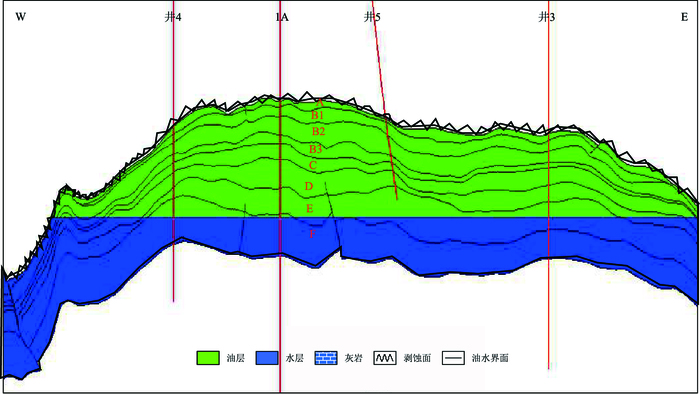 |
| 图1 流花礁灰岩油藏剖面图 Fig. 1 Geologic section of limestone reservoir |
流花礁灰岩油藏孔渗关系分布如图 2所示,储层孔隙度为3.30%
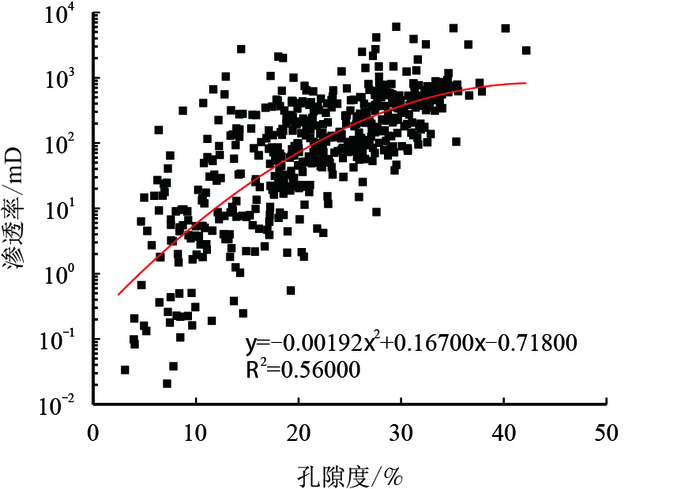 |
| 图2 流花礁灰岩油藏孔渗关系分布图 Fig. 2 The relationship between porosity and permeability of Liuhua 11-1 reservoir |
整个储层具有亲油—强亲油特性,且各小层表现出孔隙度中等偏弱非均质性、渗透率强非均质性的特点(表 1)。
| 表1 流花礁灰岩油藏各小层物性参数分布及润湿性 Table 1 Porosity and permeability of each layer in Liuhua 11-1 reservoir |
礁灰岩储层微观孔隙结构与常规砂岩孔隙储层的微观孔隙结构差异明显。根据薄片分析结果,流花礁灰岩储层孔洞缝类型多样(图 3),包括粒间孔、粒内孔、粒间溶蚀孔、粒内溶孔、生物体腔孔和溶洞共6类孔,以及溶蚀、层间、构造和压溶共4类缝并以发散状(图 3k)和复杂网状缝(图 3l)为主。喉道类型主要有孔隙缩小型(图 3c)、缩颈型(图 3a)、弯片状喉道(图 3e)共3类。不同的孔缝洞组合类型构成了不同的储集空间,具有强的储层微观非均质性。
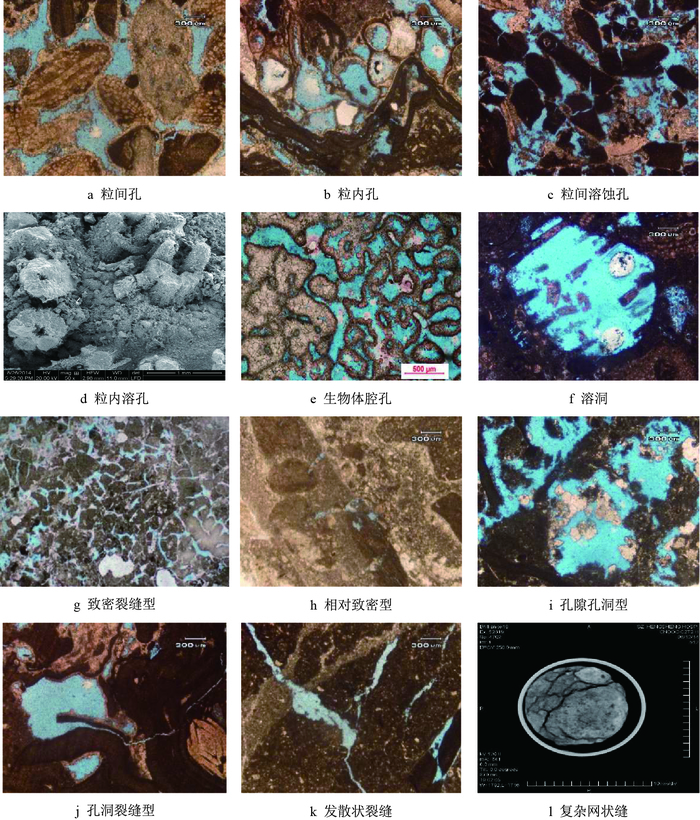 |
| 图3 礁灰岩储层孔、洞、缝特征 Fig. 3 Types of fractures and pores of reef limestone reservoir |
聚类分析不同孔隙及裂缝类型岩芯的毛管压力曲线发现,流花礁灰岩储层具有4类典型的微观孔隙结构(图 4),每类储层的岩性及孔隙结构参数统计分析结果见图 5、表 2、表 3。各类储层具有孔隙半径分布形态差异较小、喉道差异大、孔喉比大的特点。
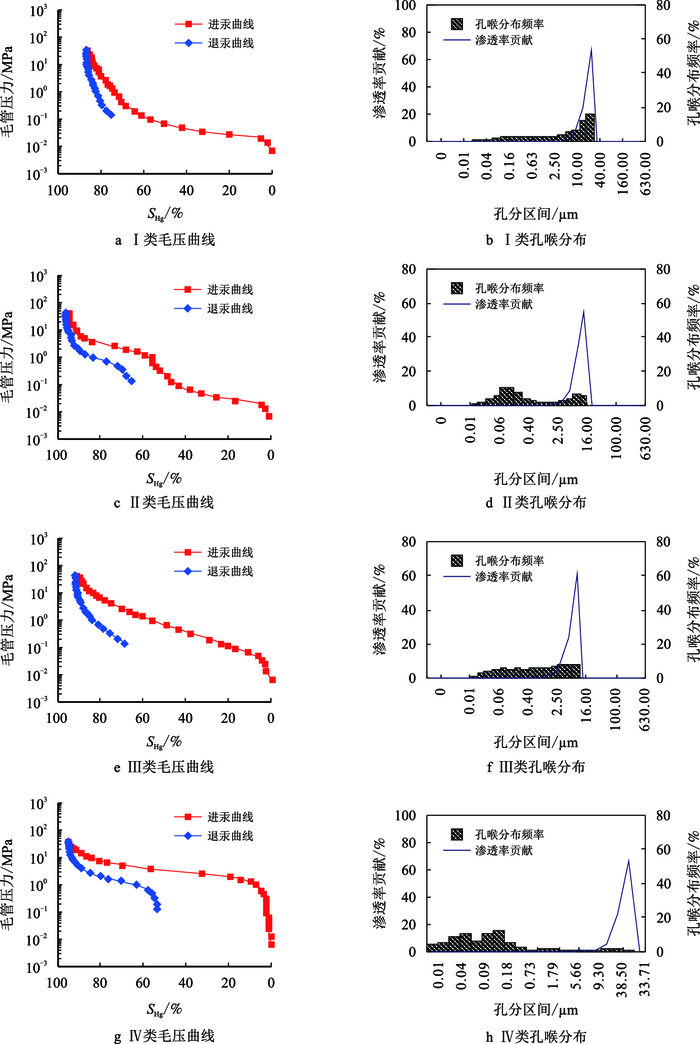 |
| 图4 高压压汞实验结果 Fig. 4 The results of mercury injection curves experiment |
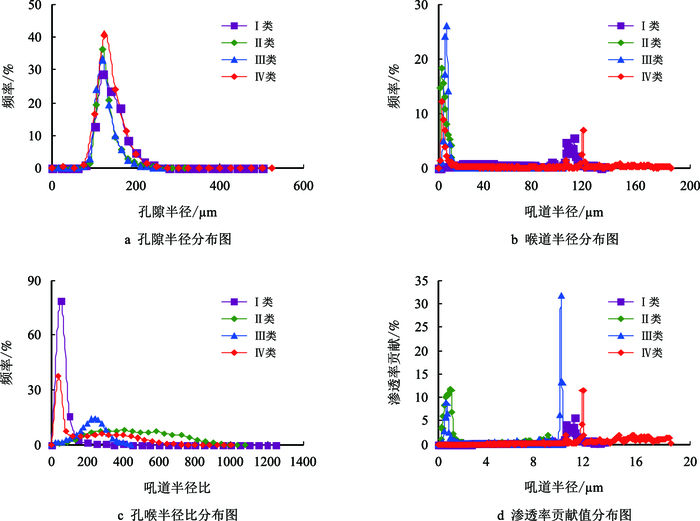 |
| 图5 恒速压汞实验测试分析结果 Fig. 5 Analysis results of constant-rate mercury penetration experiment |
| 表2 礁灰岩储层各类孔隙结构特征参数 Table 2 The characteristics of different pore structure types of reef limestone reservoir in oilfield |
| 表3 恒速压汞实验孔隙结构特征参数 Table 3 Characteristic parameters of pore throat structure by constant-rate mercury penetration experiment |
Ⅰ类:压汞曲线呈现出“低平缓段”特征,曲线形态相对偏向于横坐标,孔隙分布为后峰型。平均孔隙半径200.99 µm,主流喉道半径14.40 µm,孔喉比为23.81。表现出高孔、高渗、高特征结构系数、大孔径特点。在镜下铸体薄片中可见孔隙、溶洞连片发育,并作为优势渗流通道相互连通,储渗流能力好。
Ⅱ类:压汞曲线呈现出“裂缝-孔隙双重介质”特征,孔隙分布为双峰型。平均孔隙半径175.16 µm,主流喉道半径10.27 µm,孔喉比大且分布范围广,平均孔喉比180.74。在镜下铸体薄片中可见发育孔隙、孔洞及裂缝,其中,裂缝作为“桥梁”将孔洞系统连通。
Ⅲ类:压汞曲线呈现出“倾斜直线”特征,孔隙分布为平峰型。渗流通道为微裂缝,平均孔隙半径121.35 µm,主流喉道半径较小(1.93 µm),平均孔喉比176.37。在镜下铸体薄片中可见网状裂缝,基质相对致密,孔隙相对不发育,但发育一定的微裂缝。
Ⅳ类:压汞曲线呈现出“高平缓段”特征,孔隙分布为前峰型。局部发育微孔隙,平均孔隙半径120.53 µm,主流喉道最窄(0.42 µm),孔喉半径比高达413.45,孔喉差异程度最高在镜下铸体薄片中显示该类孔隙结构相对致密,发育局部微裂缝和溶孔,但孔喉半径小、连通性差,表现出较差的储渗能力。
流花礁灰岩储层微观孔隙结构参数总体有以下特点:
(1) 低排驱压力。研究区各类储层的排驱压力在0.004
(2) 低退汞效率。研究区各类储层的退汞效率在12.9%
(3) 储层非均质性较强。研究区各类储层的平均孔隙结构分选系数为2.45
(4) 孔喉半径比和可渗流主要孔道与储层类型关系密切。不同储层平均孔隙半径、主流喉道半径、孔喉半径比、平均喉道半径等参数差异明显,随着孔隙结构变差,渗流阻力增大,可渗流孔道比例大幅度降低。
3 驱替特征礁灰岩储层微观孔隙结构特性与流体渗流机理、渗流特征与渗流规律有直接的关系。图 6~图 10是用10 mm
 |
| 图6 Ⅰ类孔隙结构的微观水驱油实验结果(孔洞均匀分布) Fig. 6 Experimental results of microscopic water-oil displacement of Ⅰ type pore structure |
 |
| 图7 Ⅰ类孔隙结构的微观水驱油实验结果(孔洞不均匀分布) Fig. 7 Experimental results of microscopic water-oil displacement of Ⅰ type pore structure |
 |
| 图8 Ⅱ类孔隙结构的微观水驱油实验结果 Fig. 8 Experimental results of microscopic water-oil displacement of Ⅱ type pore structure |
 |
| 图9 Ⅲ类孔隙结构的微观水驱油实验结果 Fig. 9 Experimental results of microscopic water-oil displacement of Ⅲ type pore structure |
 |
| 图10 Ⅳ类孔隙结构的微观水驱油实验结果 Fig. 10 Experimental results of microscopic water-oil displacement of Ⅳ type pore structure |
(1) Ⅰ类储层的孔隙、孔洞分布均质程度是影响油水分布状态和驱油效率的关键因素。非均质性较弱的孔洞系统其油水分布状态比较均匀,仅局部分布受微观非均质影响较大,水驱油过程也较均匀,不存在突进现象,驱替效率较高。而非均匀分布孔洞系统中,大孔洞周围的基质存在侵染现象,驱油效率低。
(2) Ⅱ类储层的孔洞缝发育极不均匀,导致油水分布不均,除基质油动用程度差外,溶孔中的油也不易被采出,水驱油效率差。
(3) Ⅲ类储层是发育裂缝的致密基质,毛细管力渗吸作用下,模拟油存在于裂缝及裂缝周围的致密基质中,弥漫性侵润现象突出。水驱过程中,水沿裂缝优势渗流通道窜流,基质油难动用。在驱替压力作用下,局部大孔道中的剩余油以及基质油饱和度还有进一步增加的趋势,水驱油效率低。
(4) Ⅳ类储层动用难度更大,见水很长时间后的水驱效果仍不理想。
表 4、表 5是基于40块小岩芯、7块全直径岩芯、4块长岩芯的水驱油实验结果汇总表,图 11是3块典型岩芯的水驱油动态实验结果,可以看出,礁灰岩岩芯表现出如下驱替特征:(1)礁灰岩岩芯水驱油效率整体较低(表 4,表 5),主要是受亲油润湿性、复杂孔隙结构和高原油黏度等因素共同导致的。(2) 表 4显示孔洞分布的均匀性对驱油效率影响大,渗透率为305.7 mD的Ⅰ类孔洞非均匀分布的岩芯驱油效率仅28.40%;(3) 表 5显示小岩芯驱油效率最大,全直径岩芯驱油效率最小,而组合长岩芯驱油效率居中,因为小岩芯仅受微观孔隙结构的影响,全直径岩芯(包括宏观非均质特性)比小岩芯更丰富,因此,小岩芯驱油效率最大,全直径岩芯驱油效率最小,而含各种储层的组合长岩芯对非均质特性有相互抵消作用,其驱油效率居中。(4) 图 11显示礁灰岩储层无水采油期短,含水率曲线呈“厂”字型,见水后含水率迅速上升到90%以上,其驱油动态不同于常规砂岩储层。
| 表4 不同孔隙结构岩芯的驱替实验数据 Table 4 The data of displacement experiment of different pore structures |
| 表5 不同孔渗岩芯的驱替实验数据 Table 5 The data of water-oil displacement experiment of different rock cores |
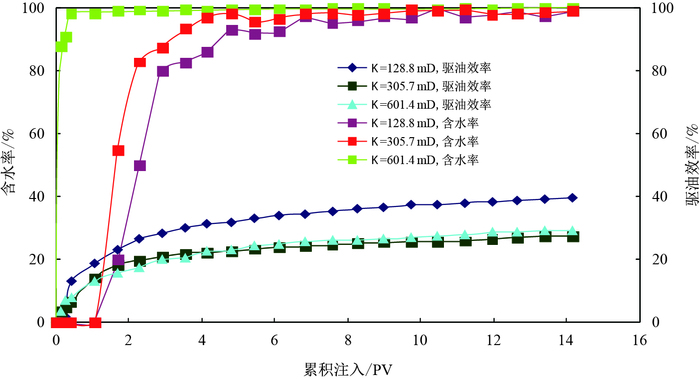 |
| 图11 岩芯驱替实验结果 Fig. 11 Experimental results of water-oil displacement |
(1) 流花礁灰岩储层微观性质表现出低排驱压力、低退汞效率、强非均质性、强亲油、低驱油效率的特点。孔隙结构为4类:Ⅰ类孔洞发育,毛管压力曲线呈“低平缓段”;Ⅱ类孔洞裂缝发育,毛管压力曲线呈“双峰型”;Ⅲ类基质致密,发育网状裂缝,毛管压力曲线呈倾斜直线;Ⅳ类整体致密,毛管压力曲线呈“高平缓段”。其中有利储层主要为Ⅰ、Ⅱ、Ⅲ类,储层渗流能力与储层类型关系密切,主控因素有储层类型、孔喉半径比和润湿性3个关键因素。
(2) 流花礁灰岩储层的微观剩余油主要以孤立点珠、不规则浸染状及油膜3种形式附着于裂缝或大孔道附近,基质中的油较难被采出。水沿优势渗流通道窜流及亲油润湿性是影响微观水驱油效率的关键因素,共同导致了“厂”字型的含水上升规律及低驱油效率。
| [1] |
岳大力, 林承焰, 吴胜和, 等. 储层非均质定量表征方法在礁灰岩油田开发中的应用[J].
石油学报, 2004, 25(5): 75–79.
YUE Dali, LIN Chengyan, WU Shenghe, et al. Application of quantitative method for characterizing reservoir heterogeneity to the development of reef limestone reservoir[J]. Acta Petrolei Sinica, 2004, 25(5): 75–79. doi: 10.3321/j.issn:0253-2697.2004.05.015 |
| [2] |
岳大力, 吴胜和, 林承焰, 等. 礁灰岩油藏隔夹层控制的剩余油分布规律研究[J].
石油勘探与开发, 2005, 32(5): 113–117.
YUE Dali, WU Shenghe, LIN Chengyan, et al. Remaining oil distribution controlled by intercalation in reef limestone reservoir[J]. Petroleum Exploration and Development, 2005, 32(5): 113–117. |
| [3] |
侯连华, 吴锡令, 林承焰, 等. 礁灰岩储层渗透率确定方法[J].
石油学报, 2003, 24(5): 67–70.
HOU Lianhua, WU Xiling, LIN Chengyan, et al. Determination of permeability in ecologic reef reservoir[J]. Acta Petrolei Sinica, 2003, 24(5): 67–70. doi: 10.3321/j.issn:0253-2697.2003.05.014 |
| [4] |
刘勇, 杨洪志, 刘义成, 等. 阿姆河右岸基尔桑地区牛津阶生物礁储层特征及控制因素[J].
天然气工业, 2013, 33(3): 10–14.
LIU Yong, YANG Hongzhi, LIU Yicheng, et al. Characteristics and main controlling factors of the Oxfordian biohermal reservoirs in Girsan of Amu Darya Right Bank, Turkmenistan[J]. Natural Gas Industry, 2013, 33(3): 10–14. doi: 10.3787/j.issn.1000-0976.2013.03.003 |
| [5] |
李海波, 郭和坤, 周尚文, 等. 低渗透储层可动剩余油核磁共振分析[J].
西南石油大学学报(自然科学版), 2016, 38(1): 119–127.
LI Haibo, GUO Hekun, ZHOU Shangwen, et al. NMR analysis of movable remaining oil of low pemeability reservoir[J]. Journal of Southwest Petroleum University (Science & Technology Edition), 2016, 38(1): 119–127. doi: 10.11885/j.issn.1674-5086.2014.06.04.01 |
| [6] |
李易霖, 张云峰, 尹淑丽, 等. 致密砂岩储集空间多尺度表征——以松辽盆地齐家地区高台子油层为例[J].
石油与天然气地质, 2016, 37(6): 915–922.
LI Yilin, ZHANG Yunfeng, YIN Shuli, et al. Characterization of the pore space in tight sandstone reservoirs from macroscopic and microscopic perspectives:A case study of Gaotaizi reservoir in Qijia Area, the Songliao Basin[J]. Oil & Gas Geology, 2016, 37(6): 915–922. doi: 10.11743/ogg20160613 |
| [7] |
詹俊阳, 马旭杰, 何长江. 塔河油田缝洞型油藏开发模式及提高采收率[J].
石油与天然气地质, 2012, 33(4): 655–660.
ZHAN Junyang, MA Xujie, HE Changjiang. Development scheme and EOR technique of fracture-vug reservoirs in Tahe Oilfield[J]. Oil & Gas Geology, 2012, 33(4): 655–660. doi: 10.11743/ogg20120423 |
| [8] |
蔡忠. 孤岛、孤东油田馆上段微相特征与剩余油分布[J].
石油与天然气地质, 2000, 21(3): 256–258.
CAI Zhong. Characteristics of microfacies and distribution of remaining oil in upper Member of Guantao Formation from Gudao and Gudong Oilfields[J]. Oil & Gas Geology, 2000, 21(3): 256–258. doi: 10.11743/ogg20000315 |
| [9] |
司马立强, 王超, 王亮, 等. 致密砂岩储层孔隙结构对渗流特征的影响——以四川盆地川西地区上侏罗统蓬莱镇组储层为例[J].
天然气工业, 2016, 36(12): 18–25.
SIMA Liqiang, WANG Chao, WANG Liang, et al. Effect of pore structure on the seepage characteristics of tight sandstone reservoirs:A case study of upper Jurassic Penglaizhen Fm reservoirs in the western Sichuan Basin[J]. Natural Gas Industry, 2016, 36(12): 18–25. doi: 10.3787/j.issn.1000-0976.2016.12.003 |
| [10] |
况晏, 司马立强, 瞿建华, 等. 致密砂砾岩储层孔隙结构影响因素及定量评价——以玛湖凹陷玛131井区三叠系百口泉组为例[J].
岩性油气藏, 2017, 29(4): 91–100.
KUANG Yan, SIMA Liqiang, QU Jianhua, et al. Influencing factors and quantitative evaluation for pore structure of tight glutenite reservoir:a case of the Triassic Baikouquan Formation in Ma 131 Well Field, Mahu Sag[J]. Lithologic Reservoirs, 2017, 29(4): 91–100. doi: 10.3969/j.issn.16738926.2017.04.011 |
| [11] |
王伟明, 卢双舫, 李杰, 等. 致密砂岩储层微观孔隙特征评价——以中国吐哈盆地为例[J].
天然气地球科学, 2016, 27(10): 1828–1836.
WANG Weiming, LU Shuangfang, LI Jie, et al. Analyses of micro-pore structural characteristics of tight sandstone reservoirs:A case study in Turpan-Hami Basin, northwestern China[J]. Natural Gas Geoscience, 2016, 27(10): 1828–1836. doi: 10.11764/j.issn.1672-1926.2016.10.1828 |
| [12] |
赵凤兰, 李子豪, 李国桥, 等. 三元复合驱后关键储层特征参数实验研究[J].
西南石油大学学报(自然科学版), 2016, 38(5): 157–164.
ZHAO Fenglan, LI Zihao, LI Guoqiao, et al. Variation of key parameters of reservoir characteristics by ASP flooding[J]. Journal of Southwest Petroleum University (Science & Technology Edition), 2016, 38(5): 157–164. doi: 10.11885/j.issn.1674-5086.2015.04.03.13 |
| [13] |
陈朝兵, 朱玉双, 王平平, 等. H地区主力油层驱油效率影响因素[J].
岩性油气藏, 2010, 22(3): 128–132.
CHEN Zhaobing, ZHU Yushuang, WANG Pingping, et al. Influencing factors for displacement efficiency in the main reservoirs of H area[J]. Lithologic Reservoirs, 2010, 22(3): 128–132. doi: 10.3969/j.issn.1673-8926.2010.03.026 |
| [14] |
潘毅, 王攀荣, 宋道万, 等. 复杂裂缝网络系统油水相渗曲线特征实验研究[J].
西南石油大学学报(自然科学版), 2016, 38(4): 110–116.
PAN Yi, WANG Panrong, SONG Daowan, et al. Experimental researches on relative permeability curve of complex fracture system[J]. Journal of Southwest Petroleum University (Science & Technology Edition), 2016, 38(4): 110–116. doi: 10.11885/j.issn.1674-5086.2014.05.26.05 |
| [15] |
王小军, 赵飞, 张琴, 等. 准噶尔盆地金龙油田佳木河组火山岩储层孔隙类型及特征[J].
石油与天然气地质, 2017, 38(1): 144–151.
WANG Xiaojun, ZHAO Fei, ZHANG Qin, et al. Pore types and characteristics of volcanic reservoirs of the Jiamuhe Formation in Jinlong Oilfield, Junggar Basin[J]. Oil & Gas Geology, 2017, 38(1): 144–151. doi: 10.11743/ogg20170115 |
| [16] |
龚小平, 唐洪明, 赵峰, 等. 四川盆地龙马溪组页岩储层孔隙结构的定量表征[J].
岩性油气藏, 2016, 28(3): 48–57.
GONG Xiaoping, TANG Hongming, ZHAO Feng, et al. Quantitative characterization of pore structure in shale reservoir of Longmaxi Formation in Sichuan Basin[J]. Lithologic Reservoirs, 2016, 28(3): 48–57. doi: 10.3969/j.issn.1673-8926.2016.03.008 |
| [17] |
郭文敏, 李治平, 吕爱华, 等. 气体示踪表征CO2驱渗流特征实验研究[J].
西南石油大学学报(自然科学版), 2015, 37(1): 111–115.
GUO Wenmin, LI Zhiping, LÜ Aihua, et al. The experiment study of using gas tracer on analysis the mechanism of CO2 flooding[J]. Journal of Southwest Petroleum University (Science & Technology Edition), 2015, 37(1): 111–115. doi: 10.11885/j.issn.1674-5086.2012.12.24.03 |
| [18] |
陈志海, 戴勇, 郎兆新. 缝洞性碳酸盐岩油藏储渗模式及其开采特征[J].
石油勘探与开发, 2005, 32(3): 101–105.
CHEN Zhihai, DAI Yong, LANG Zhaoxin. Storagepercolation modes and production performance of the karst reservoirs in Tahe Oilfield[J]. Petroleum Exploration and Development, 2005, 32(3): 101–105. |
| [19] |
邓少贵, 赵岳, 李栗, 等. 火山岩岩石微观特征及其测井宏观表征[J].
西南石油大学学报(自然科学版), 2015, 37(6): 170–180.
Deng Shaogui, Zhao Yue, Li Li, et al. Microscopic characteristics and logging macro characterization of volcanic rocks[J]. Journal of Southwest Petroleum University (Science & Technology Edition), 2015, 37(6): 170–180. doi: 10.11885/j.issn.1674-5086.2014.05.24.03 |
| [20] |
吴浩, 刘锐娥, 纪友亮, 等. 典型致密砂岩气储层孔隙结构分类及其意义——以鄂尔多斯盆地盒8段为例[J].
天然气地球科学, 2016, 27(5): 835–843.
WU Hao, LIU Ruie, JI Youliang, et al. Classification of pore structures in typical tight sandstone gas reservoir and its significance:A case study of the He 8 Member of upper Palaeozoic Shihezi Formation in Ordos Basin, China[J]. Natural Gas Geoscience, 2016, 27(5): 835–843. doi: 10.11764/j.issn.1672-1926.2016.05.0835 |
| [21] |
任晓霞, 李爱芬, 王永政, 等. 致密砂岩储层孔隙结构及其对渗流的影响——以鄂尔多斯盆地马岭油田长8储层为例[J].
石油与天然气地质, 2015, 36(5): 774–779.
REN Xiaoxia, LI Aifen, WANG Yongzheng, et al. Pore structure of tight sand reservoir and its influence on percolation:Taking the Chang 8 reservoir in Maling Oilfield in Ordos Basin as an example[J]. Oil & Gas Geology, 2015, 36(5): 774–779. doi: 10.011743/ogg20150508 |
| [22] |
薛冰, 张金川, 唐玄, 等. 黔西北龙马溪组页岩微观孔隙结构及储气特征[J].
石油学报, 2015, 36(2): 138–149, 173.
XUE Bing, ZHANG Jinchuan, TANG Xuan, et al. Characteristics of microscopic pore and gas accumulation on shale in Longmaxi Formation, northwest Guizhou[J]. Acta Petrolei Sinica, 2015, 36(2): 138–149, 173. doi: 10.7623/syxb201502002 |
| [23] |
李超正, 柳广弟, 曹喆, 等. 鄂尔多斯盆地陇东地区长7段致密砂岩微孔隙特征[J].
天然气地球科学, 2016, 27(7): 1235–1247.
LI Chaozheng, LIU Guangdi, CAO Zhe, et al. The study of Chang 7 tight sandstone micro pore characteristics in Longdong Area, Ordos Basin[J]. Natural Gas Geoscience, 2016, 27(7): 1235–1247. doi: 10.11764/j.issn.1672-1926.2016.07.1235 |
| [24] |
刘晓鹏, 刘燕, 陈娟萍, 等. 鄂尔多斯盆地盒8段致密砂岩气藏微观孔隙结构及渗流特征[J].
天然气地球科学, 2016, 27(7): 1225–1234.
LIU Xiaopeng, LIU Yan, CHEN Juanping, et al. Characteristics of micro pore structure and seepage in tight sandstone gasreservoir of the 8th section of Shihezi Formation in Ordos Basin, China[J]. Natural Gas Geoscience, 2016, 27(7): 1225–1234. doi: 10.11764/j.issn.1672-1926.2016.07.1225 |
| [25] |
徐黎明, 牛小兵, 梁晓伟, 等. 华庆地区长6致密油储层微观孔喉结构特征[J].
西南石油大学学报(自然科学版), 2017, 39(4): 36–46.
XU Liming, NIU Xiaobing, LIANG Xiaowei, et al. Microscopic characteristics of pore-throat structures of the Chang 6 Member tight oil layer in the Huaqing Region[J]. Journal of Southwest Petroleum University (Science & Technology Edition), 2017, 39(4): 36–46. doi: 10.11885/j.issn.16745086.2016.03.28.03 |
 2017, Vol. 39
2017, Vol. 39


